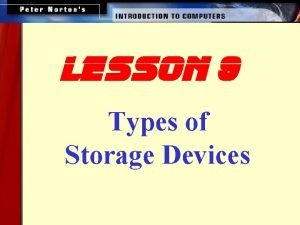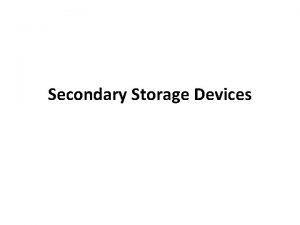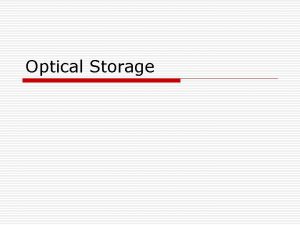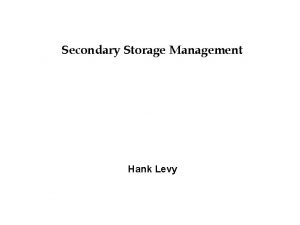Chapter No 4 Secondary Storage Devices Optical Storage







- Slides: 7

Chapter No. 4 Secondary Storage Devices

Optical Storage Devices

Optical storage Devices � Optical storage systems store and read data using light, often storing information on what is called an optical disk. The most popular types of optical storage devices are drives that read and write CDs, DVDs and Blu-ray disks. Scientists continue to explore ways to cram more data onto disks that can fit into a compact space.

CD ROM � CD stands for "Compact Disc Read-Only Memory. " A CD-ROM is a CD that can be read by a machine with an optical drive. � The "ROM" part of the word means that the data on the disk is "read-only" or cannot be changed or erased. The first CD-ROMs could carry around 600 MB of data. � CD-ROM is typically used to store software programs. CDs can store audio and video data, as well as text and program instructions

CD ROM � During the 1990 s, CD-ROMs were popularly used to distribute software and data for computers and fourth generation video game consoles. � Early CD-ROM drives were called single speed, and read data at a rate of 150 KBps. (Hard disks transfer data at rates of 5 – 15 MBps). CD-ROM drives now can transfer data at speeds of up to 7800 KBps. Data transfer speeds are getting faster.

DVD-ROM � Digital versatile disc-read only memory (DVD-ROM). � The first DVD-ROMs were produced in Japan in November 1996. It was launched in the United States in March 1997. � It is a read-only digital versatile disc (DVD) commonly used for storing large software applications.

DVD ROM � It is similar to a compact disk-read only memory (CDROM) but has a larger capacity. � A DVD-ROM stores about 4. 38 GB of data. Normally, a CD-ROM stores 650 MB of data. � A DVD-ROM indefinitely holds data files that cannot be modified, overwritten or erased.
 Magnetic tape is a direct access storage medium
Magnetic tape is a direct access storage medium What are optical storage devices are most commonly known as
What are optical storage devices are most commonly known as Primary storage vs secondary storage
Primary storage vs secondary storage Primary storage and secondary storage
Primary storage and secondary storage Secondary storage provides temporary or volatile storage
Secondary storage provides temporary or volatile storage Secondary storage devices diagram
Secondary storage devices diagram Magnetic tape in secondary memory
Magnetic tape in secondary memory Introduction to storage
Introduction to storage












